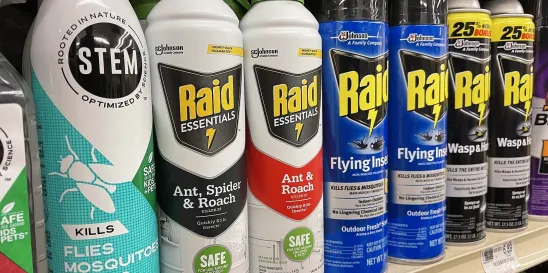On February 1, 2024, the U.S. Environmental Protection Agency (EPA) released guidance to clarify how it will evaluate “absence of an ingredient” claims for pesticide products regulated under the Federal Insecticide, Fungicide, and Rodenticide Act (FIFRA). EPA states that it is aware that the regulated community seeks clarity on whether and how “absence of an ingredient” claims can be made lawfully on FIFRA-regulated product labels.
EPA states that it will consider an “absence of ingredient” claim on a case-by-case basis and may allow the claims if there is information that ensures the claims are not false or misleading. In addition, EPA states that in some instances, “absence of an ingredient” claims should include a qualifying statement that is prominently displayed and adjacent to the claim to limit the potential to mislead or confuse the public.
EPA’s guidance document discusses the following three commonly requested “absence of an ingredient” claims:
- “Bleach-free” claim:
- EPA states that it understands that a “bleach-free” claim is not generally viewed as a safety claim and thus not misleading on certain products because it can help users better understand that bleach is in a product to ensure they do not apply the product to items that bleach may damage (e.g., clothing).
- “Phosphate-free” claim:
- EPA states that it would generally not consider the claims to be misleading when used on products because phosphates are considered as inert ingredients and have no pesticidal purpose.
- As phosphate typically would be added to a formulation as an inert ingredient and, therefore, would not be identified on the label, consumers typically would not be able to discern whether a product contains phosphate or is phosphate free without an explicit label claim.
- A declaration of phosphate content on the product label is consistent with EPA’s initiative and actions taken by states and localities to combat nutrient pollution in U.S. water bodies.
- “DEET-free” claim:
- EPA states that it understands that there are reasons consumers want to have information about whether pesticide products contain DEET, other than perceptions about its safety, (e.g., odor and potential damage to plastic, rubber, vinyl, and elastic on items like clothing and backpacks).
- Under the guidance, EPA states that it would generally not consider these specific claims to be false or misleading when accompanied by a qualifying statement like the following: “Not a safety claim.”
- In the guidance, EPA states that it will generally allow “absence of DEET” claims to be used on the labeling of EPA-registered repellents that are applied to human skin and clothing for insects or ticks, as long as they are qualified to ensure that consumers are not misled about the safety of the product for humans or the environment relative to other products that contain DEET.
Application Process
The guidance provides information for how applicants or registrants may add these claims to its pesticide product labeling. EPA states that it recommends that an applicant or registrant wishing to make an “absence of an ingredient” claim on their pesticide product labeling include in the application an explanation of the purpose of the claim and how the claim is narrowly stated to limit the potential to mislead users about the safety of the product for humans or the environment (e.g., with the use of an appropriate qualifying statement that is prominently displayed and adjacent to the claim). To further support the “absence of an ingredient” claim, the applicant or registrant may provide supporting data and/or information (e.g., consumer surveys) demonstrating that the claim would not be misleading to users. If EPA determines that a proposed “absence of an ingredient” claim is not false or misleading because it is used for purposes other than conveying information about product safety for humans or the environment and is supported by data and/or information demonstrating that the claim would not be misleading to users and/or appropriately qualified to limit the potential to mislead users, then the claim would be approved.
EPA states that if a registrant wants to understand better whether to submit data and/or information to EPA as part of an application, it may contact EPA before gathering the data and/or information.
EPA provides the following table to outline the actions that can be taken by applicants and registrants who wish to modify their applications or registrations based on this guidance.
| Scenario | Action* |
| (1) Your product is currently registered with EPA; (2) You would like to amend your product’s labeling based on this guidance; and (3) You are not submitting data/information (e.g., consumer survey) for EPA’s review. | Submit a non-coded Pesticide Registration Improvement Act (PRIA) labeling amendment to EPA. |
| (1) Your product is currently registered with EPA; (2) You would like to amend your product’s labeling based on this guidance; and (3) You are submitting data/information (e.g., consumer survey) for EPA’s review. | Submit a PRIA labeling amendment to EPA. |
| (1) Your product is not currently registered with EPA; and (2) You would like to propose product labeling based on this guidance. | Submit the appropriate PRIA application, typically in the new active ingredient, new use, or new product PRIA categories, to EPA. If you would like to include data/information (e.g., consumer survey) for EPA’s review, provide the data/information with the initial application submitted to EPA. |
*For questions about the pesticide application submission process, please consult the appropriate chapters in EPA’s Pesticide Registration Manual, a resource for companies and individuals who want to have their pesticide products registered for sale in the United States.
Minimum Risk Pesticide
EPA also states in the new guidance that to the extent that an “absence of an ingredient” claim is not false or misleading, then such a claim would not disqualify an otherwise qualified minimum risk pesticide from exemption under 40 C.F.R. Section 152.25(f).
Commentary
This announcement by EPA is significant since it appears to change what was considered relatively inviolate for decades in the pesticide registration world. Comparative safety claims have been a recurring issue over the decades, especially when there is public controversy about a particular pesticide. The regulations and policies have been generally consistent, and they avoid comparative claims, based on the idea that even a “better” or “more safe” pesticide might signal to a user that label directions on the “safer” product are of less importance or significance. All registered pesticides are considered to offer some — perhaps very small — level of risk, and the full label is to be followed to avoid unreasonable risks. This is the principle behind the explicit statutory requirement that every registered pesticide must include the (famous) phrase: “It is a violation of Federal law to use this product in a manner inconsistent with its labeling.”
Over the years, EPA has tried to communicate more effectively to pesticide users some notion that certain products might be considered “environmentally preferable” and worth communicating that EPA suggestion to consumers. By the 1990s, EPA developed the Design for the Environment (DfE) program and suggested that phrase and label mark might be something a product could have for easier and direct communication to a user.
Some products took advantage of this approach, but during the Obama Administration, EPA’s Office of Chemical Safety and Pollution Prevention (OCSPP) set off to develop a program to communicate clearly and directly to the consumer. In 2015, OCSPP replaced the DfE designation with the “Safer Choice” program, since the word “Safer” was more effective in directly communicating to consumers (for more information, see https://www.epa.gov/saferchoice/learn-about-safer-choice-label). At that time, however, with the choice of “safer” in the revised program mark, OCSPP knew that it would necessarily exclude registered pesticides from qualifying for the program since comparative safety claims were not allowed under FIFRA regulations.
Similarly, as EPA developed its list of “FIFRA Section 25(b)” pesticides that would be exempt from federal registration requirements, EPA stated an intent to encourage better communication to the public about less hazardous products — so much “less,” they did not need any EPA review (depending on whether the Section 25(b) product made “public health” claims — but that is another issue about communicating effectively to the consumer).
This short history is relevant to indicate some of the long and complicated path and history behind comparative claims.
The current announcement not only appears to reverse long-standing policies and interpretations of regulatory requirements, but it is also unclear about how it will prevent other comparative claims. If affecting fabrics and odor issues will allow direct comparison to other products if there is an explanatory asterisk with a more precise explanation, EPA may see some surprising claims that were previously forbidden. One example of using smell to justify a comparative claim could come for home and garden products — hundreds of herbicide products containing 2,4-D are used widely in the home market and have a smell of mercaptan (the smell added to natural gas as a warning) — and some consumers believe that 2,4-D is unsafe. That pesticide has been through registration review many times and has a long trail of EPA assessments reaffirming its qualification for continued registration. Can this new policy allow “Contains No 2,4-D” products to have an asterisk somewhere that says “will avoid mercaptan odors” as the rationale for the label on the front of the product label?
The rationale presented by EPA also is not clear that odor and fabric impact claims will be the only reasons to allow that a product is “XXX-Free.”
It seems easy to predict some manufacturers will attempt to fit claims such as “Contains No Chlorpyrifos” or “No Organophosphates” or “No Glyphosate” since these are currently controversial pesticides. Could these be allowed on labels with an asterisk claiming some objectional odor, some reference to effects on clothing, or other rationale which now might be found acceptable to EPA under this revised policy?
This may set off new suggestions that are literally true and not a direct safety comparison (color, consistency, smell) — which might allow “XXX-Free” on a label if the asterisk indicates this is not a safety element or that the compared product is registered by EPA. Like uncertainty about the phrase “Design for the Environment,” few consumers may recognize product distinctions other than those that appear in more prominent type on the front of the product.
The “Absence of an Ingredient” Claims Guidance is available on EPA’s website under “Product Label Topics.”




 />i
/>i

